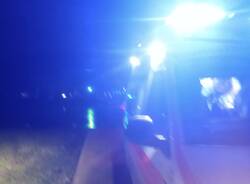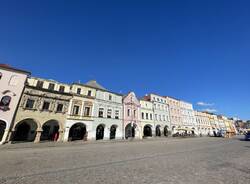Casa Bellora, the fifth Liberty-style building in Piazza Garibaldi
Ninety years ago, old houses with porticoes gave way to the sumptuous house of the Bellora family: to this day, the building and its interiors still tell the story of the golden age of the textile industry, of which Gallarate was the capital.

Where there were only a few houses with porticoes, a majestic house was built, obstructing the view onto the square dedicated to Garibaldi. It was 1929, the last year of the roaring Twenties, just before the global economic crisis, when the great Casa Bellora was built, a fine example of Gallarate’s late Liberty style, which even today embellishes the central square.
Discovering the stained glass windows, the staircase and the elegant rooms of the building is a journey into the Gallarate of the time, the small capital of the textile industry of the Upper Milanese area, from Legnano to Gallarate, which was the prime mover of Italian industrialisation.
Before the current Bellora house on the square, just next to the “Teatro Condominio”, there was a simple house with an arcade and porch, similar to the very old houses that surrounded (and partly still surround) the nearby Piazza Libertà. The captain of industry, Carlo Bellora, who had factories in Gallarate, Somma, Albizzate, and in the Bergamo area, and who employed thousands of workers, hired the architect Moroni to build a house that would provide accommodation, above all, to his family.
The Tenconi-Moroni studio was the most celebrated in the town; it had built numerous villas for the most important families, starting with those of the Borgomaneri, in the “Liberty district”, between Corso Sempione and the railway, thereby extending the village of Gallarate for the first time, towards Somma.
In 1929, Carlo Bellora (who was born in 1887, and who died in 1948) moved to the new house, from his previous house in Corso Sempione, with his wife, Margerita, and their five children: his eldest sons, Filippo and Claudio, who were of his wife Elisa Sironi, who died in 1918, of “Spanish flu”, and the younger children, Elisa, Angelo and Pietro, who were of his second wife, Margherita Sironi.
“Filippo was my father, Carlo was my grandfather,” said Carlo Bellora, the musician, who still lives in the house, on the first floor, which has kept many rooms in their original state. It recounts family memories, and also a “genealogy” of the other people who lived in the building. “On the ground floor, there was the studio, and the home of the lawyer Guido Sironi, the future mayor of the town. The lawyer Piceni, who was Sironi’s son-in-law, had his office on the ground floor, and his home on the second. And finally, there was Mrs Missaglia on the second floor, with her daughters Cesira, who would marry into the Bonicalzi family, and Ada, who would marry a Sironi, from Via Dante.”
After the Second World War, the Bellora family stayed in the building: Filippo, on the first floor, and Elisa, who was known as Lisetta, first on the mezzanine floor and then on the second floor (where she lived until 2006). The ground floor rooms are now occupied by the Studio Lainati, including what was originally designed by Bellora and by the Tenconi-Moroni Studio to be bank premises, with an elegant independent entrance on the corner of the square and Via San Francesco, which, today, is always closed.
Inside, although the large atrium, with its stained-glass window, and the staircase have been modified, with the inclusion of a modern elevator, they still have a grand appearance that suggests the interiors of the private rooms, which have, in part, remained as they were, with prestigious architectural features, and their wooden and velvet furniture. Other rooms have undergone successive changes, for example, with the intervention by Silvio Zanella; today, Zanella is known as an artist and tireless promoter of art in the town, but he also worked as an interior decorator (this aspect is celebrated in the exhibitions marking the centenary of his birth).
From the windows, the eye captures Piazza Garibaldi, which is certainly more cluttered with cars than in the past. “My grandfather was a keen photographer,” Carlo Bellora continued, “and would take photos of the square from here.” One photo shows the porticoes of the Hotel Tre Re in the background, towards St. Peter’s, which was later demolished to make way for the Casa del Fascio (which today is modestly called “Palazzo Minoletti”). Another was taken from under the portico of the Tre Re, and shows the Palazzo Bellora, which had just been built.
The restoration work on Palazzo Bellora dates back to the 1920s, and was among the most successful in terms of how it transformed the town, which underwent a lot of state-funded work (such as the steps of the station, and the Crenna Steps) and privately-funded work “such as the Orlandi family’s “house of stone” and the neo-Gothic Casa Marcora. And the building itself encourages you to discover other parts of the town related to the Bellora family (the large atrium with its stained-glass windows, comes to mind) and other details of the building (the windows of the Bellora rest home, in Piazza Giovane Italia, behind the hospital, which was also built in 1929). The furniture still has fabrics and velvet that were produced by the Bellora factories, including the one in Gallarate with its workers’ village.
Still today, the moderate Liberty style of the house provides an elegant backdrop to Piazza Garibaldi and accompanies the eye (as in the photo at the top of this article) to another building by the Tenconi-Moroni studio, the “residential house” on the corner of Via San Francesco, Via Roma and Piazza Risorgimento, from 1924.
TAG ARTICOLO
La community di VareseNews
Loro ne fanno già parte
Ultimi commenti
Tsilvia su La patente a 18 anni? "Non è più uno status symbol"
PaoloFilterfree su "La sanità pubblica è a rischio privatizzazione": la raccolta firme on line contro il taglio delle tariffe
elenera su La patente a 18 anni? "Non è più uno status symbol"
Felice su La patente a 18 anni? "Non è più uno status symbol"
Alessandra Toni su "La sanità pubblica è a rischio privatizzazione": la raccolta firme on line contro il taglio delle tariffe
lenny54 su "La sanità pubblica è a rischio privatizzazione": la raccolta firme on line contro il taglio delle tariffe

















Accedi o registrati per commentare questo articolo.
L'email è richiesta ma non verrà mostrata ai visitatori. Il contenuto di questo commento esprime il pensiero dell'autore e non rappresenta la linea editoriale di VareseNews.it, che rimane autonoma e indipendente. I messaggi inclusi nei commenti non sono testi giornalistici, ma post inviati dai singoli lettori che possono essere automaticamente pubblicati senza filtro preventivo. I commenti che includano uno o più link a siti esterni verranno rimossi in automatico dal sistema.